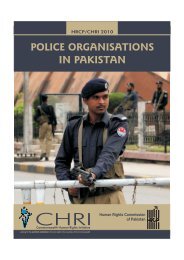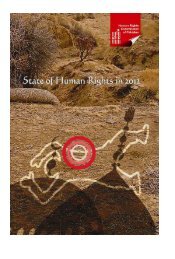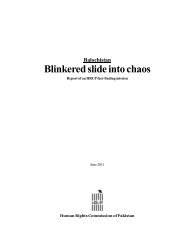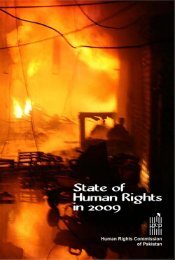Judical Action to end Bonded Labour - Human Rights Commission ...
Judical Action to end Bonded Labour - Human Rights Commission ...
Judical Action to end Bonded Labour - Human Rights Commission ...
You also want an ePaper? Increase the reach of your titles
YUMPU automatically turns print PDFs into web optimized ePapers that Google loves.
worker then has <strong>to</strong> get up early in the morning around dawn and start<br />
putting this paste in<strong>to</strong> the moulds which process then continues till he has<br />
exhausted the earthen paste prepared by him. It may also be mentioned<br />
here that the brick-kiln owner has allocated <strong>to</strong> each worker a particular<br />
number of 'KATCHA' bricks <strong>to</strong> be prepared by him. The persons involved<br />
in this part of operation are called PATHAIRAS'. After these 'KATCHA'<br />
bricks are prepared the job of PATHAIRAS' is over.<br />
(b) These 'KATCHA' bricks are then carried <strong>to</strong> the actual kiln. This carriage is<br />
ordinarily done with the assistance of 'donkeys' and the persons:<br />
performing this function are called 'KUMHARS'.<br />
(c) The next process is the setting of the 'KATCHA' bricks in the kiln which<br />
has <strong>to</strong> be done in a very systematic and scientific manner and again<br />
requires skill. This process is called 'BHARAI and the persons involved in<br />
this' BHARAI' are called ëBHARAIASí.<br />
(d) Then follows the process where these 'KATCHA' bricks are then heated<br />
for their being baked as final bricks. This process is called 'JALAI' and the<br />
persons involved are called as 'JALAIAS'. The final process is called<br />
'NIKAS' which means carrying the bricks out of the kiln for onward<br />
transportation <strong>to</strong> the market.<br />
11. EMPLOYER-EMPLOYEE RELATIONSHIP<br />
(a) My discussions and enquiries have revealed that the problem of<br />
malpractice in the brick-kiln Industry is confined mainly <strong>to</strong> the category of<br />
labourers who are TATHERAS'. The reason perhaps is that this is the<br />
category of workers who form the majority of workers in a brick-kiln and<br />
are even otherwise important for the production of bricks.<br />
(b) It has transpired that the brick-kiln owners do not directly employ the<br />
labour for their purposes and that the workers are engaged by the brickkiln<br />
owners through a middle-man who is called the 'JAMADAR'. The<br />
PATHERAS' are paid on work charge basis meaning thereby that they<br />
are paid according <strong>to</strong> the number of 'KATCHA' bricks that they have<br />
prepared. The rate <strong>to</strong>day at which these ëPATHERASí are paid is Rs.35<br />
<strong>to</strong> 50 per thousand 'KATCHA' bricks. I am quoting this rate according <strong>to</strong><br />
the payments being made by the brick-kilns around Lahore. Besides this<br />
payment which is made <strong>to</strong> the PATHERAS' the 'JAMADAR' is also paid<br />
some amount which is his commission for providing labour <strong>to</strong> the brickkiln<br />
owners and this commission is also based on the number of<br />
'KATCHA' bricks prepared by the 'PATHERAS'. The 'JAMADAR' does not<br />
only provide labour <strong>to</strong> the brick-kiln owners but is also responsible for<br />
their continuous working with the Brick-Kiln Owners and the 'JAMADAR'<br />
is the one who is responsible also for ensuring that these 'PATHERAS'<br />
do not run away and do not leave the employment of the concerned<br />
brick-kiln.<br />
(c) Another practice in this industry is that the workers in the brick-kiln<br />
especially the 'PATHERAS' are given 'ADVANCES' known as 'PESHGI',<br />
at the time of joining the particular brick-kiln. According <strong>to</strong> the prevailing<br />
practice, r<strong>end</strong>ition of accounts is done at the <strong>end</strong> of each week. The<br />
number of 'KATCHA' bricks prepared by each 'PATHERA' is determined<br />
and the amount thus due <strong>to</strong> him is accordingly fixed. Ordinarily half of the<br />
amount found due <strong>to</strong> a 'PATHERA' is ìadjusted <strong>to</strong>wards the 'PESHGI'<br />
advanced <strong>to</strong> him and the remaining half is paid <strong>to</strong> him in cash. According<br />
--- 27 ---











